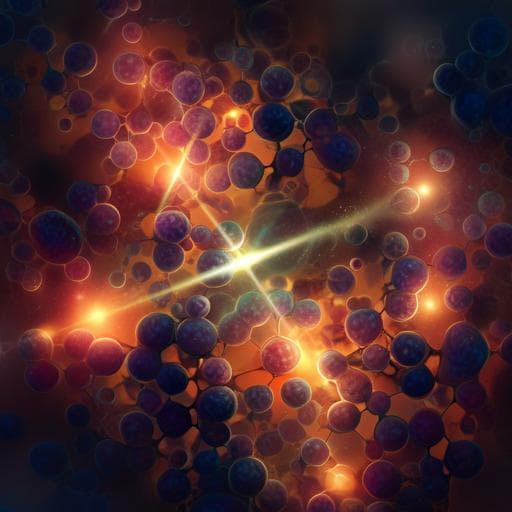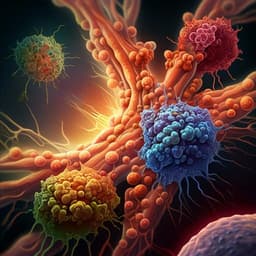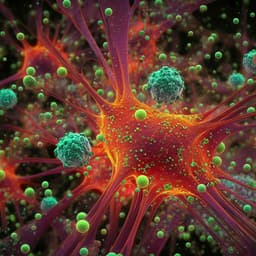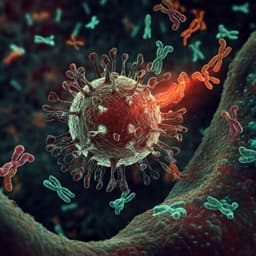
Medicine and Health
Single cell analysis reveals distinct immune landscapes in transplant and primary sarcomas that determine response or resistance to immunotherapy
A. J. Wisdom, Y. M. Mowery, et al.
Immunotherapy alone often falls short for cancer patients, but groundbreaking research by Amy J. Wisdom and her colleagues reveals the powerful synergy of radiotherapy and PD-1 blockade in treating sarcomas. This study uncovers how different tumor models impact immune response, offering new insights into personalized cancer treatment strategies.
~3 min • Beginner • English
Introduction
Many cancer patients receive radiotherapy (RT), and preclinical studies in transplanted tumor models have shown RT can synergize with immune checkpoint inhibitors to elicit systemic antitumor immunity through CTL- and type I interferon-dependent mechanisms. However, most preclinical immunotherapy studies use transplant models that do not develop under immune surveillance and may overestimate clinical responses. This study investigates why immune checkpoint blockade combined with RT cures transplant sarcomas but fails in autochthonous (primary) sarcomas derived from the same high-mutational-load mouse model. The overarching goal is to delineate tumor-intrinsic and microenvironmental mechanisms of response and resistance, focusing on how coevolution of tumors with the immune system shapes immune tolerance, neoantigen expression, myeloid remodeling, and CD8+ T cell states, and to contextualize these murine immune phenotypes relative to human sarcoma immune classes.
Literature Review
Prior work has established synergy between RT and checkpoint inhibitors (e.g., CTLA-4 and PD-1/PD-L1 blockade) in transplanted tumor models, with RT acting as an in situ vaccine dependent on type I interferon signaling and TREX1 regulation. Clinical trials are testing combinations of RT and immunotherapy with mixed outcomes. Tumor mutational burden correlates with response to checkpoint blockade, and neoantigen-directed immune pressure can drive immune editing and escape. In soft tissue sarcomas, transcriptional immune classes (SIC) spanning immune-low to immune-high and vascular phenotypes correlate with response to PD-1 blockade and survival, with certain classes (e.g., immune-inflamed) enriched for cytotoxic signatures, MHC-I expression, and macrophage phenotypes. Single-cell analyses in other cancers have linked specific myeloid states and activated/exhausted CD8+ T cell subsets with responsiveness to PD-1 therapy. These studies underscore the need to characterize primary tumor immune ecosystems and their remodeling by immunotherapy and RT.
Methodology
Mouse models: An autochthonous high-mutational-load sarcoma model was generated by intramuscular injection of Adeno-Cre into Tp53fl/fl mice to delete Tp53, followed by 3-methylcholanthrene (MCA) to induce primary p53/MCA undifferentiated pleomorphic sarcomas (UPS). A cell line derived from an induced primary tumor was orthotopically transplanted into the gastrocnemius of syngeneic mice to create transplant tumors. Additional primary sarcomas were generated in Rag2−/− (lymphocyte-deficient) and Rag2+/− (immune-competent) littermates using CRISPR/Cas9 approaches.
Therapies: Mice bearing tumors received RT (commonly 20 Gy single fraction; additional doses including 10 Gy or 60 Gy in specified experiments) with or without immune checkpoint blockade: anti–PD-1 alone or combined with anti–CTLA-4. Treatment commenced when tumors exceeded ~70 mm3. Survival was assessed by Kaplan–Meier; mice were censored as cured if tumors were undetectable for ≥26 days.
Transplantation and tolerance assays: For self versus non-self experiments, primary tumors were amputated at ~70 mm3; cell lines were established and injected orthotopically into donor (self) mice and naïve syngeneic mice, as well as T cell–deficient athymic mice. To test reversal of tolerance, donor and naïve mice received lethal total body irradiation (TBI) followed by bone marrow transplant (BMT) before challenge with self tumor cells.
Sequencing and computational analyses: Whole-exome sequencing (WES) of tumor and matched liver identified somatic mutations. RNA-seq (bulk) profiled gene expression and assessed expression of predicted neoantigens. Neoantigen prediction used netMHC to evaluate mutant 8–11mer peptides with IC50 ≤500 nM or affinity score >50 nM; expression considered if both mutant and wild-type reads were >5. CIBERSORT/CIBERSORTx deconvolved immune cell composition from bulk RNA-seq of murine tumors and The Cancer Genome Atlas (TCGA) sarcomas, comparing murine models to human sarcoma immune classes (SIC). Mass cytometry (CyTOF) with a 37-marker panel quantified PD-L1+ macrophages after treatments. Single-cell RNA sequencing (10x Genomics Chromium, v2 chemistry) of FACS-sorted live CD45+ tumor-infiltrating immune cells was performed 3 days post-treatment (anti–PD-1 or isotype; 0 or 20 Gy for primary tumors). Cell Ranger and Seurat were used for QC (filtering by gene and mitochondrial content), clustering, and differential expression; GSVA assessed pathway activity. Myeloid subclustering characterized macrophage/monocyte/DC states; lymphoid subclustering identified CD8+ T cell phenotypes (activated, cycling, memory/exhausted). Statistical analyses included ANOVA, t-tests, Wilcoxon tests, and multiple-testing corrections as specified.
Key Findings
- Therapeutic responses: Transplant p53/MCA sarcomas were cured by PD-1 blockade and by RT, and combined PD-1+CTLA-4 blockade with RT also cured transplant tumors. Identical regimens failed to cure primary p53/MCA sarcomas.
- Immune tolerance: Tumor cell lines re-implanted into their donor (self) mice grew with 100% penetrance and shorter latency versus naïve mice and were resistant to cure by anti–PD-1 + RT. The same lines implanted into naïve mice responded markedly better, with more than half of treated mice cured (52%). Non-self tumor lines were rejected by naïve and donor mice (but not by athymic mice). TBI+BMT restored donors’ ability to reject self transplants to levels comparable to naïve mice.
- Immune editing and neoantigens: Primary tumors harbored more nonsynonymous mutations than transplant tumors (P < 0.001). In primary tumors, anti–PD-1 reduced nonsynonymous mutations by ~15%, and adding RT reduced them by ~40% within 3 days. The fraction of nonsynonymous mutations expressed as neoantigens was significantly lower in primary than transplant tumors (P < 0.001). For expressed neoantigens, gene expression levels were similar between models. Rag2−/− versus Rag2+/− primary tumors showed differences consistent with immune editing (e.g., nonsynonymous mutation differences, P = 0.01; neoantigen expression differences, P = 0.036).
- Human–mouse parallels: Bulk RNA-seq and CIBERSORT mapped untreated transplant tumors to immune-inflamed human sarcoma classes (notably SIC E in UPS from TCGA) associated with higher PD-1 response, whereas primary tumors resembled less inflamed classes more typical of the broader sarcoma population.
- Macrophage/PD-L1: CyTOF revealed abundant PD-L1+ macrophages at baseline in transplant tumors that decreased after RT; PD-L1+ macrophages were rare in primary tumors and did not change significantly after RT.
- scRNA-seq overview: 98,219 immune cells profiled (including 73,039 myeloid). Tumor model type dominated immune transcriptional differences more than treatment.
- Myeloid states: Transplant tumors were enriched for interferon-stimulated, inflammatory macrophage clusters (e.g., high C1q, Stat1, Irf1), whereas primary tumors were dominated by immunosuppressive macrophage populations (clusters Y5, Y7, Y8) expressing anti-inflammatory genes and TGF-β–associated programs. RT (±PD-1) in primary tumors reprogrammed myeloid cells, increasing interferon response and antigen presentation pathways (Stat1/Irf3/Irf7 signatures) and decreasing TGF-β pathway activity.
- CD8+ T cells: Bulk deconvolution indicated higher CD8+ T cell abundance in transplant tumors, mirroring human immune-high sarcomas. scRNA-seq showed transplant tumors enriched for activated and cycling CD8+ T cells expressing activation/exhaustion markers (Pdcd1, Havcr2/Tim-3, Lag3, Ctla4, Entpd1), with increased granzymes (GzmA/B) and proliferation genes after PD-1 therapy. Primary tumors contained far fewer activated CD8+ T cells; CD8+ T cells exhibited elevated Wnt/β-catenin and Myc target signaling at baseline, which further increased after PD-1, potentially contributing to dysfunction. PD-1 therapy induced some cytotoxic programs in primary CD8+ T cells but did not generate the activated states associated with therapeutic cure.
Discussion
The study demonstrates that despite deriving from the same genetic model, primary and transplant sarcomas develop fundamentally different immune ecosystems that dictate responses to immunotherapy and RT. Transplant tumors, not shaped by prolonged immune surveillance, display an inflamed microenvironment with interferon-polarized myeloid cells and abundant activated/cycling CD8+ T cells, enabling cures with PD-1 blockade and RT. In contrast, primary tumors coevolve with the host immune system, undergoing immune editing to reduce expressed neoantigens and fostering immunosuppressive myeloid states and CD8+ T cell programs (including heightened Wnt/β-catenin) linked to tolerance and resistance. Although PD-1 blockade and RT reprogram myeloid cells in primary tumors toward interferon responses and away from TGF-β signaling, the lack of enrichment for activated CD8+ T cells appears to limit therapeutic efficacy.
Self versus non-self transplantation and BMT experiments further support that primary tumor development induces systemic immune tolerance specific to coevolved tumor antigens, which can be reset by replacing the immune system. Cross-species transcriptomic comparisons indicate that most human sarcomas resemble the immune phenotype of primary murine tumors, whereas a subset (e.g., SIC E) resembles transplant tumors and is more likely to respond to PD-1 therapy. These observations suggest that immune contexture—particularly activated CD8+ T cell states and myeloid polarization—underlies responsiveness and should guide patient selection and combination strategies (e.g., targeting TGF-β or Wnt/β-catenin pathways) to overcome resistance.
Conclusion
This work defines distinct immune landscapes in primary versus transplant sarcomas and shows that these differences drive divergent outcomes to PD-1 blockade and RT. Transplant tumors, enriched for interferon-polarized myeloid cells and activated/cycling CD8+ T cells, are curable with PD-1 ± RT, whereas primary tumors exhibit immune tolerance, reduced expression of neoantigens, immunosuppressive myeloid programs, and paucity of activated CD8+ T cells, leading to resistance. Myeloid compartments in primary tumors can be reprogrammed by RT and PD-1, but without concurrent enrichment of activated CD8+ T cells, cures are not achieved. Translationally, patients whose sarcomas mirror the inflamed, transplant-like phenotype (e.g., SIC E) may benefit most from PD-1 ± RT, while those with primary-like phenotypes may require strategies that augment antigen presentation, mitigate TGF-β/Wnt-β-catenin signaling, and specifically expand activated tumor-specific CD8+ T cells. Future research should identify interventions that convert tolerant primary tumor immune ecosystems into inflamed, CD8+-active states and validate immune class–guided treatment selection in clinical sarcoma cohorts.
Limitations
- Preclinical mouse models may not fully recapitulate human sarcoma heterogeneity and treatment responses.
- Most mechanistic analyses were performed at an early timepoint (3 days post-treatment), which may miss later immune dynamics.
- Some datasets had modest sample sizes (e.g., n = 4–8 per group in transcriptomic comparisons), potentially limiting statistical power.
- Self versus non-self transplantation and BMT experiments, while informative, may have confounders related to irradiation and reconstitution.
- Not all code for variant/neoantigen analyses was released (proprietary pipeline), which may limit reproducibility.
- Experiments were not blinded to treatment groups, introducing potential bias.
- Single-cell filtering thresholds and clustering choices can influence cell state definitions; cross-validation across platforms and timepoints would strengthen conclusions.
Related Publications
Explore these studies to deepen your understanding of the subject.







